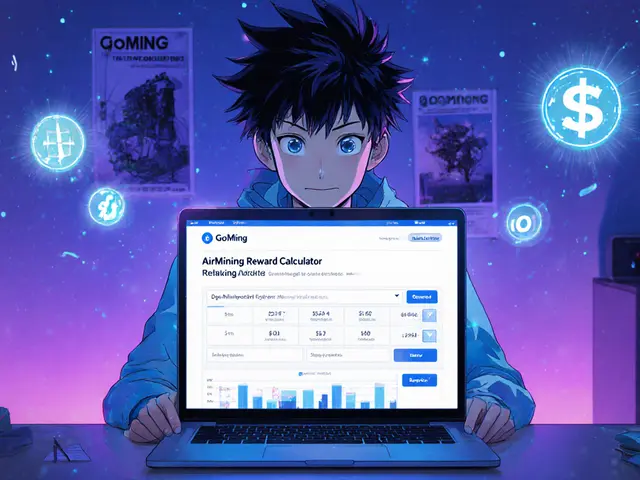Leverage Calculator
Calculate Your Trading Exposure
Estimate potential profits and losses with different leverage levels. Remember: Higher leverage increases risk significantly.
When it comes to trading crypto, OrangeX is a web‑based cryptocurrency exchange launched in 2021 and registered in Seychelles that aims to serve both retail and institutional traders. This OrangeX crypto exchange review breaks down what the platform actually offers, how its costs stack up, and whether the lack of formal regulation is a deal‑breaker.
Core Offering and Trading Types
The platform supports a wide range of spot trading for 389 cryptocurrencies and also provides futures trading with perpetual contracts. Leverage can go up to 1:200, letting aggressive traders amplify positions, while a copy‑trading service lets novices mirror seasoned strategies. For developers, an API and algorithmic trading suite are available, making the exchange attractive for automated strategies.
Fee Structure - What You’ll Actually Pay
OrangeX advertises a tiered fee model. Spot trades carry a flat 0.10% maker and taker fee. Futures fees range from 0.02% to 0.05% depending on volume. Some users have reported promotional periods with 0.00% fees, but these appear limited and not the default. Deposits as low as USDT10 are accepted, and withdrawals are charged per blockchain network - typically a few dollars for major coins.

Security Measures and Regulation Gaps
On the security front, the exchange employs cold‑storage for the majority of assets, two‑factor authentication via Google Authenticator, and regular penetration tests. However, regulation is a sticking point: OrangeX is not licensed by any financial authority, which means user funds have less legal protection compared with regulated rivals.
Liquidity and Market Depth
One of OrangeX’s selling points is deep liquidity. The platform claims to aggregate order books from multiple liquidity providers, resulting in tight spreads even on less‑traded pairs. Market‑depth visuals in the web UI show real‑time order flow, a feature usually reserved for institutional platforms.
User Experience - Desktop and Mobile
The desktop web app is sleek, with customizable chart panels and a responsive layout. The mobile app, available on Google Play, has amassed 195 user reviews with an average rating of 4.2 stars. Positive feedback highlights the quick UI and helpful support, while negative reviews point to occasional glitches that prevent order placement. Users have asked for alternative verification methods beyond Google Authenticator and for built‑in trading bots.

Pros, Cons, and How OrangeX Stacks Up
| Exchange | Spot fee | Futures fee | Max leverage | Regulation | Supported cryptos |
|---|---|---|---|---|---|
| OrangeX | 0.10% | 0.02‑0.05% | 1:200 | Unregulated | 389 |
| Binance | 0.10% | 0.02‑0.04% | 1:125 | Partially regulated (various jurisdictions) | ~ 5,000 |
| Coinbase | 0.50% (no‑maker‑taker split) | N/A | 1:3 | US regulated (NYDFS, FINRA) | ~ 250 |
| Kraken | 0.16% (maker) | 0.02% (maker) | 1:50 | US regulated (FinCEN) | ~ 350 |
From the table you can see that OrangeX offers aggressive leverage and a decent spot fee, but it lags behind the sheer variety of coins on Binance and the regulatory safety of Coinbase and Kraken.
- Pros: High leverage, deep liquidity, advanced charting, API access, low entry deposit.
- Cons: No regulatory license, occasional mobile app bugs, limited customer‑service hours.
Bottom Line - Is OrangeX Worth Your Money?
If you’re a seasoned trader who values leverage and wants a platform that rolls out new features fast, OrangeX can be a solid choice-provided you’re comfortable storing assets on an unregulated exchange. Beginners might prefer a regulated alternative to avoid potential legal complications. Always start with a small amount, test the UI, and keep an eye on withdrawal processing times (1‑5 business days for fiat transfers).
Frequently Asked Questions
Is OrangeX regulated?
No. OrangeX is registered in the Seychelles and does not hold a license from any major financial regulator. Users should consider the associated risks.
What cryptocurrencies can I trade on OrangeX?
The exchange lists about 389 coins and tokens, covering major assets like BTC, ETH, USDT, as well as many smaller altcoins.
How high is the leverage on OrangeX?
Leverage options go up to 1:200 for futures contracts, which is among the highest in the market.
What are the deposit and withdrawal fees?
Deposits are free when using supported crypto wallets. Fiat deposits via bank card or transfer may incur a small processing fee. Withdrawal fees depend on the blockchain used, typically a few dollars for Bitcoin or Ethereum.
Is there a mobile app and how reliable is it?
Yes, OrangeX offers Android and iOS apps. Reviews are mixed: many praise the speed and UI, but some report crashes that can block order execution.







Comments
Wayne Sternberger
October 13, 2025 AT 09:13 AMIt's important to understand the fee structure before committing capital. OrangeX's 0.10% maker‑taker rate is comparable to larger exchanges, yet the lack of tiered discounts may affect high‑volume traders. The platform's deep liquidity is a plus, but newcomers should test the UI with a small amount first. Remember to enable two‑factor authentication and store the bulk of your holdings in cold storage. Treat the exchange as a tool, not a vault, and you’ll mitigate most of the risk.
Gautam Negi
October 13, 2025 AT 10:20 AMWhile many celebrate OrangeX's aggressive leverage, one must consider the inherent volatility such leverage introduces. The platform's unregulated status does not automatically render it unsafe, yet it does remove a layer of legal recourse. In a market already fraught with manipulation, a 1:200 multiplier can amplify both profit and ruin in equal measure. Therefore, the claim that OrangeX is merely a high‑risk playground is overly simplistic. A measured participant will weigh these factors against personal risk tolerance.
Shauna Maher
October 13, 2025 AT 11:43 AMThe moment I saw the OrangeX promotional page, I sensed a hidden agenda. Their sleek UI is a classic veneer that masks a deeper lack of oversight. Operating out of the Seychelles means the exchange sits outside the jurisdiction of any major financial watchdog, effectively placing traders in a legal vacuum. Every deposit you make is a silent surrender of personal assets to an entity that can disappear overnight without a trace. The high leverage of up to 1:200 is nothing short of a reckless invitation to ruin, especially when the platform advertises "deep liquidity" that is likely manufactured by undisclosed market makers. Cold‑storage claims are common parlance, but without a regulated custodian there is no guarantee that the majority of funds are truly offline. Two‑factor authentication is a drop‑in security measure that does little when the underlying corporate structure is opaque. Withdrawal fees tied to blockchain congestion can be manipulated, turning ordinary users into perpetual profit generators for the exchange. I have encountered numerous reports of order execution glitches that have left positions open during rapid market moves, effectively handing losses to the trader. The lack of a formal compliance department suggests that any internal audit is either non‑existent or deliberately hidden. In the crypto world, anonymity is a double‑edged sword; it protects privacy but also shields malicious operators. The platform's copy‑trading feature may appear convenient, yet it is a conduit for inexperienced users to adopt the strategies of possibly unscrupulous traders. Moreover, the mobile app's instability is a red flag, as it indicates insufficient quality assurance processes. If an exchange cannot guarantee basic operational stability, one must question its ability to safeguard funds. All these elements combine into a portrait of an exchange that prioritizes rapid growth over genuine user protection, and that should set off alarm bells for anyone valuing security above hype.
Kyla MacLaren
October 13, 2025 AT 13:06 PMi see ur point and agree that the security story is shaky, but maybe testing with a tiny amount could reveal if the platform lives up to its claims.
Linda Campbell
October 13, 2025 AT 14:30 PMFrom a patriotic perspective, entrusting American investors' capital to an offshore, unregulated entity such as OrangeX undermines our nation’s financial sovereignty. Domestic exchanges subject to U.S. oversight provide a framework of consumer protection that foreign jurisdictions simply cannot match. The allure of high leverage should not eclipse the responsibility to support regulated markets that contribute to national economic stability. It is incumbent upon disciplined traders to favor platforms that align with our national interests and legal safeguards.
John Beaver
October 13, 2025 AT 15:53 PMTechnically speaking, the API latency on OrangeX is competitive, yet the absence of a transparent audit trail raises concerns about order integrity. For algorithmic strategies, consistent data feeds are essential; any hidden manipulation could skew back‑testing results. Users should implement redundant logging and monitor slippage closely when operating on unregulated venues. This mitigates potential discrepancies and preserves the reliability of automated systems.
Jazmin Duthie
October 13, 2025 AT 17:16 PMSure, just hand over your savings to a mystery shop in the ocean.
Michael Grima
October 13, 2025 AT 18:40 PMWow, brilliant plan – blissful oblivion.
Mandy Hawks
October 13, 2025 AT 20:03 PMContemplating the nature of risk, one might view leverage as a mirror reflecting our own appetite for uncertainty. In the grand tapestry of finance, each trader weaves a thread colored by personal tolerance and ethical considerations. OrangeX, with its unbounded leverage, invites a dialogue about the balance between ambition and prudence. Perhaps the true lesson lies not in the platform itself, but in the introspection it provokes within each participant.
Scott G
October 13, 2025 AT 21:26 PMIt is understandable to feel conflicted when faced with such potent financial tools, and acknowledging that internal tension is the first step toward informed decision‑making. By approaching the exchange with measured caution, one can align personal values with practical risk management, thereby fostering both confidence and responsibility.